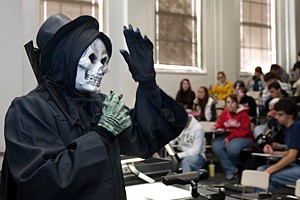
VIDEO: 'Dr. Ghoul' Gets Students Psyched About the Personalities of Halloween
University of Cincinnati students in a Psychology 102 class took on a psychology-related Halloween challenge on Oct. 30 as part of Associate Professor Ken Ghees Chiller Thriller Halloween Personality Class.
Leading the class was a figure dressed in long, black garb with the mask of a skeleton, identifying himself as Dr. Ghoul and announcing that he was filling in for Professor Ghee. Feel free to die laughing as you witness the face of fear, he said, chuckling.
The lesson today explored the aspects of the personality that can be reflected by the characters roaming about on Halloween. Good and evil are eternal forces, Dr. Ghoul explained. They will never go away in your life. Halloween captures our fears and our desires.
In psychological terms, he explained that the unconscious mind is operated by the id, the instinctual impulses that can reflect the dark, irrational side of the personality. It adheres to the pleasure principle.
The super ego, on the other hand, was a source of the best that we can be, he said the morality principle. The ego delved into the rational, logical side of the personality, the reality principle.
I want you to think seriously now, young brothers and sisters, about the forces in your life that are preventing you from being what you want to be, he said.
As part of a class project, nearly a dozen students took on a challenge to come to class in a Halloween costume and explain why what they were wearing reflected the id (the dark irrational side of the personality) or the ego (the good rational aspects of the personality). The class of 230 students ranging from freshmen to seniors voted for their favorite presentation according to three criteria:
- Describe which character they related to the most and explain why
- Select which costume was the best and explain why
- Offer comment and feedback on the class presentation

Sarah Palin or Tina Fey?
One student first introduced herself as Sarah Palin and then as Tina Fey playing Sarah Palin. The student explained that she uses her wit to get out of a lot of situations. Tina Fey gets paid millions, but I just get into trouble, she said.

The Joker
Student Eric Dickerson told the class that he dressed as the Joker, because he, too, used jokes and laughter to get out of tough situations.
One student, dressed in pale green, explained that he was a highlighter. I dont have much in common with the pen, but Im bright and fun and happy.
A student portraying a witch told the class to vote for her because she was crazy and wicked and really cool.

witch
A group of students announced they were Cinderella and the step-sisters. The girls were roommates and good friends, and announced that they all agreed that the student portrayed as Prince Charming was truly charming.
A student dressed as an angel said she sees herself as good-natured and a good listener. I see myself on the bright side, not the dark side, she said.

angel
A student dressed as a bright green M&M and identifying himself as Andy said that he was slightly diabetic, so for me as a diabetic kid, the scariest thing I could think of was a giant piece of candy!
Once the presentations were over, Dr. Ghoul brought all the contestants to the front of the classroom for one last Monsters Ball.
The class is a new aspect of Ghees innovation in higher education series, linking psychology to pop culture. In Halloween tradition, the students also got a tasty treat, as Dr. Ghoul threw candy into the crowd of students.
Related Stories
Ancient Maya blessed their ballcourts
April 26, 2024
Using environmental DNA analysis, researchers identified a collection of plants used in ceremonial rituals in the ancient Maya city of Yaxnohcah. The plants, known for their religious associations and medicinal properties, were discovered beneath a plaza floor upon which a ballcourt was built, suggesting the building might have been blessed or consecrated during construction.
OTR mural centerpiece of 'big' celebration of UC alumni
April 26, 2024
New downtown artwork salutes 18 alumni award recipients who personify UC’s alumni success.
From literature to AI: UC grad shares career path to success
April 23, 2024
Before Katie Trauth Taylor worked with international organizations like NASA, Boeing and Hershey, and before receiving accolades for her work in the generative AI space, she was in a much different industry: English and literature.
